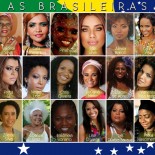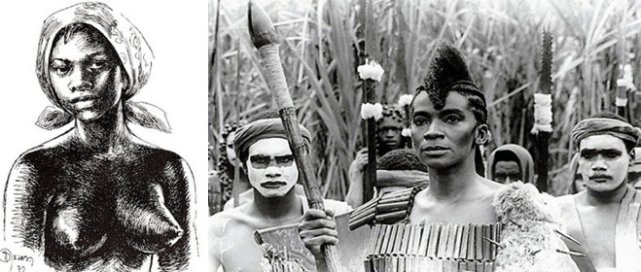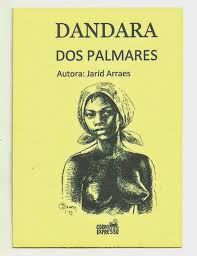November 20, 2014
Dandara,
the wife of Zumbi,
Brazil’s greatest
black leader,was a
revolutionary
warrior
in her own right
Note from BW of Brazil: The story of Afro-Brazil’s greatest leader, Zumbi of the quilombo known as Palmares, is a figure whose memory is etched into the names of countless groups and organizations who have some sort of connection to the modern day Afro-Brazilian struggle for racial equality. Zumbi’s name, legacy, history and mythology is so prominent in Brazil’s history that even those who know nothing about Afro-Brazilian History at least know his name. But as often happens in history, female figures who were nearly or actually equal to or more important than their male counterparts are often forgotten, erased or not recognized in the history books. Such a case applies to Dandara of Palmares, Zumbi’s heroic wife, who was a warrior in her right and actually preceded her husband in death during the battle for the liberty of Afro-Brazilians in the 17th century. As history has not devoted nearly as much historical research about Dandara, we may never be able to give a proper treatment to her historical importance, but with today’s piece, on the eve the 319th anniversary of her husband’s death, celebrated as the National Day of Black Consciousness throughout Brazil, BW of Brazil is proud to present the information we do have about her.
And Dandara of Palmares, do you know who she was?
By Jarid Arraes
November is officially the Month of the Black Consciousness in Brazil. While it is important and necessary, especially because it is a country that had centuries of enslavement of black people, this date is still quite uncomfortable for a portion of the population. Even so, the month of November mobilizes the Movimento Negro (black movement) and awakens a temporary interest in schools, institutions and news, which often superficially addressed the issue of racism in the period near the 20th.
Those who speak of this date often recall of Zumbi of Palmares, which is the great icon of the struggle against racism for his resistance against slavery. Even in school, many heard about Zumbi and learned that he was the leader of the Quilombo of Palmares, where black men and women who escaped slavery could find refuge and political organization. However, very few know who Dandara of Palmares was, a figure as important as Zumbi.
Dandara was Zumbi’s wife, and like him, also fought with weapons for the total liberation of black men and women in Brazil; she also had goals that went to the roots of the problem and, above all, didn’t fit into the gender standards that are still imposed on women. And it is precisely because of the mark of sexism that Dandara is not even recognized or studied in schools. Unfortunately, not even the black and feminist movements mention Dandara as often as they should. On the one hand, sexism, that although it counts on the hard work of black women, doesn’t offer to them a prominent position and a voice of decision. On the other, there’s racism, which only has memory for white women.
We, black women grow up without finding ourselves in the history, poetry, literature or sociology books. Racist sexism of the society seems to tell us we have no right to representation and inspiration to break the bonds of institutional discrimination. Many know of Dandara and other important black women only because of our own solitary research, eager to discover. And unfortunately, we are the same people who fight so that these women are not erased from history.
Some researchers, such as Professor Kleber Henrique, who wrote this beautiful text about Dandara, evidence the role of this great leader and talk about her thirst for freedom. But it’s noteworthy that even today it is not known what her face was like or where she came from. If Dandara was a contemporary black woman, she would probably be frowned upon by all who refuse to see racism. Dandara didn’t want agreements for half and didn’t even sell herself in exchange for a partial liberation. She died as a heroine that she was in life and, thanks to her struggle, today we have the strength to continue the battle against Brazilian racism.
Therefore, I refuse to accept that Dandara being a forgotten figure or that she continues being remembered in the masculine shadow of Zumbi. The black woman wants and conquers her space, because she has strength, intelligence and ability to overcome sexist and racist paradigms. The Month of the Black Consciousness needs to more and more the month of Dandara of Palmares, of the absolute autonomy of black women and of complete feminine liberty, who protagonizes in the trenches of resistance against discrimination based on color and gender. Dandara lives.
Dandara: The queen lioness of Palmares
With contributions from Joana Prata, UNEGRO Rio de Janeiro and Dandara Tinoco*
On the day Zumbi was decapitated, striking a blow to black resistance, a year and nine months had already passed since the equally tragic death of the feminine face of the Quilombo of Palmares, Dandara. If the Palmares hero is celebrated on the National Day of Black Consciousness, November 20, Thursday, the story of the figure identified as his wife remains fraught with uncertainties, with scant historical records.
The first Europeans that arrived on Brazilian soil first tried to domesticate and enslave the indigenous (original inhabitants) for forced labor, however, the majority didn’t produce enough and/or died soon after the loss of freedom. Looking for a more “productive” and “profitable” work force, they then decided to kidnap and enslave Africans for fazendas de cana-de-açúcar (large sugar cane farms), the main source of wealth of the colony.
The story as we know it generally shows blacks as resigned to their situation of being enslaved in colonial Brazil, however, the reality was quite different. Many revolts were rose in the name of freedom and many blacks escaped from captivity, taking refuge in the countryside and forming free communities, the quilombos or maroon societies.
The Quilombo of Palmares was founded near the Serra da Barriga, in Alagoas, and at its peak, had more than thirty thousand inhabitants. There, the elements of nature and individuals still communed with the ideals of love of the land and freedom, quite different from the devastation caused by the monoculture and death of individual autonomy as a result of slavery.
Palmares was a multiracial kingdom where men and women were free. Runaway black, white and Indian misfits from all sides were welcomed by the community; an oasis amidst the religious, ethnic and cultural intolerance of slavery era Brazil. A kingdom where one sang, danced and fought through life. The sound of a thousand drums warmed the nights of the quilombo and their children didn’t escape from fighting to defend their freedom.
The history books couldn’t stop talking about Ganga Zumba and Zumbi in the chapter on slavery, quilombos and black resistance in the seventeenth century, so most people even without knowing much about it, know that there once existed the Quilombo of Palmares and Zumbi was its warrior leader. But there are countless other black leaders who have not entered the pages of our textbooks because despite slavery in Brazil having lasted almost 400 years, much of the information about this historical moment was erased from the pages of the Official History.
In most cases, the feminine force, just as important and active in the community, is hardly mentioned. The feminine face of Palmares was strong, active and respected as the guardian of the ancient wisdom of the earth.
Dandara, Zumbi’s wife, queen, and warrior, was a daring, powerful and loyal woman. She was also mother of his three children. The names of their children were Motumbo, Harmódio e Aristogíton. The meaning of her name is “a mais bela” (the most beautiful). Not much is known about her African ancestry, which supports the theory that she was born in Brazil and came to the Quilombo dos Palmares as a girl. In the community, she planted like everyone else and worked in the production of cassava flour. She knew how to hunt, fight capoeira, wield weapons and led the adult female phalanx of the Palmares army. She looked after children with anemia, elders, those who were disabled due to abuse suffered by the masters, the coop and the garden…
A representation of the psychological archetype of Iansã, she possessed a sensuous and determined temperament. Much of her energy was directed toward the raising of her three children with Zumbi and, above all, to maintain her ideal of freedom. Dandara respected her ancestry communing with the elements of nature and honoring her role as mother, leader and an active woman in society.
“Dandara is the most representative of female leadership in the Republic of Palmares. She participated in all the battles, all the fights, in everything that was created, organized, experienced and suffered there. Little is known about her origins: where he was born, where he came from. Some literature says that she had ancestry in the African nation of Jeje Mahin,” says anthropologist Maria de Lourdes Siqueira, a retired professor from the Federal University of Bahia (UFBa). “There is no known image of Dandara but because of her demonstrated talent, she is a strong beautiful woman, a warrior, persuasive leader, and obstinate for freedom. Dandara contributed throughout the construction of Palmares society, and to its family, socioeconomic and political organization.
Companions in love and war, Dandara and Zumbi led various attacks on the farms to liberate slaves and seize supplies, weapons and ammunition.
According to Sandra Santos, a historian and expert on the Afro-Brazilian history and culture, in the quilombo a poly-culture was practiced with foods such as maize, cassava, beans, sweet potatoes, sugarcane and banana. Palmares inhabitants knew metallurgy and manufactured tools for agriculture and warfare. They also worked with wood and ceramics. The pindoba palm, whose abundance in the region gave rise to the name of quilombo, was used in the manufacturing of oil, beverage production, house covering made of wood and the weaving of baskets and ropes. The activities were originally intended for subsistence, but the rebellious blacks also conducted trade with villages and plantations in the region.
“The work was divided and exercised according to the abilities of each. Leadership, planting and harvesting, the functions of direct and physical battle or those connected to the establishment of strategies and political organizations. All functions could be performed by people of both sexes. There were, of course, the functions most closely linked to the feminine universe: being a mother, companion, and giving first aid to children, for example,” Sandra describes.
With the expulsion of the Dutch from the Northeast of Brazil, a new demand for more slave labor came about to work the sugar plantations. The siege of Palmares was closing in so far as the ruling government and the planters sought to recapture the escaped slaves. Palmares didn’t surrender easily, managing to resist the attacks for about 50 years. Around 18 expeditions were necessary – initiated at the time by the Dutch – until the final destruction of Palmares.
Attacks on Palmares had become frequent beginning in 1630, with the Dutch invasion. According to the narrative around Dandara, she played an important role in the breakup of her husband with his predecessor, Ganga Zumba, the first major head of Quilombo of Palmares and Zumbi’s uncle. In 1678, Ganga Zumba signed a peace treaty with the government of Pernambuco. The document stated that the authorities would free Palmares inhabitants who had been made prisoners in one of the confrontations. And also the freedom of people born in Palmares, plus granting the permission to conduct trade. In exchange, from that point on, the inhabitants of the Quilombo should deliver fugitive slaves who sought shelter there.
A born leader, Dandara opposed the terms of the Tratado de Paz (Peace Treaty) signed by Ganga Zumba (Zumbi’s uncle) and the Portuguese government, which stated that free blacks would remain free and that slaves would return to being slaves; because she stood with Zumbi in that freedom is for all, regardless of whether one is a free black, enslaved, a mestiço (mixed race) or Indian. Among other negotiations, the agreement required the move of the inhabitants of Palmares to the lands of the Vale do Cacau (Valley of Cocoa). To Dandara, the treaty would bring the destruction of the Republic of Palmares and a return to slavery. Ganga Zumba was killed by one of the blacks who opposed this proposal.
As she refused to be a slave, she took her own life after being captured on February 6, 1694 and taken as a slave after the destruction of the Cerca dos Macacos, which was part of the Quilombo of Palmares. Dandara and several other quilombolas (quilombo inhbitants) threw themselves from the highest quarry in order to not to submit themselves to slavery. Dandara lived, fought and died for the right to be free.
In the Enciclopédia Brasileira da Diáspora Africana (Brazilian Encyclopedia of the African Diaspora), the researcher of Afro-Brazilian culture and composer Nei Lopes describes in the entry under Dandara: “A personality of the legendary history of Palmares. Celebrated as the great female leader of Quilombo epic, she died with the destruction of Macaco (name of the main quilombo Palmarino). However her actual existence is still shrouded in an aura of legend.”
“Did she really exist? The story of Palmares, in general, is based on documents, but there is also a lot of fabrication. It’s hard to tell if the character existed and where she came from,” Lopes opines.
As for the historian Sandra Santos, the history of the character did not earn space in the official records because we live “in a sexist and racist world.”
“Dandara, and Maria Felipa (heroine of the independence of Bahia and, therefore, of Brazil) and Luísa Mahin (leaders of Malês and Sabinada participant), are simply ignored by textbooks, but they survive in the popular imagination because they identify and are identified with the mothers and compadres scattered throughout the national territory,” she defends. “What historicity doesn’t supply, literature resolves. Popular beliefs embrace and recreate what the talk of the people favors. The tales and legends that grow around these characters transform them into myths, examples. The official texts do not recognize them yet, but they stubbornly persist in other ways. No one forgets them because they are more beautiful than the truth of the men, stronger than the history constructed by force, imposed by the power of the winners.”
(*) The reporter was named after the historic character
Source: O Globo, UNEGRO Rio de Janeiro, Jo On the Go, Portal Fórum









Comments
One Comment
Trackbacks & Pingbacks
Comments are closed.